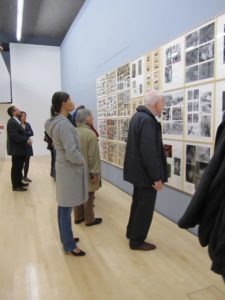A few years ago I went through a phase of being consumed with interest in Gerhard Richter’s cycle of 15 paintings, Baader-Meinhof (18. Oktober 1977). Writing this now my obsession seems doubly strange because I did not then have the geographic or cultural context for these works I have in 2013. One spring break I had seen the paintings – based upon photographs of Ulrike Meinhof, Holger Meins, Gudrun Ensslin, Andreas Baader; the funeral of Jan-Carl Raspe, and Baader’s books and record player – at the Museum of Modern Art and had a very strong reaction to them. I think I explored this subject so intently because my response was the opposite from my feelings for Franz Marc’s animals. The blurred details of the black and white photographs of portraits, news stills, and police snapshots made the subjects abjectly lifeless. The effect was like the dream of freezing; cold, sad, and bitterly empty. The paintings made me drained and ill. Yet I was fascinated by the tension – and desire – that was generated by being repelled by images whose subjects I was very drawn to.
I returned to somewhat coincidentally read one of Benjamin Buchloh’s essays on Richter (here as a downloadable PDF from the MIT Press) and realizing that Buchloh is Richter’s chronicler went immediately to the library, sat down on the floor of the stacks and read Gerhard Richter: 18. Oktober 1977 in one draught. I spent three days watching all the footage on UbuWeb and youtube of Ulrike Meinhof, read a few more books about both the paintings and the RAF, and even watched the Uli Edel movie Der Baader-Meinhof Komplex from 2008 (not good despite the tremendous aesthetic appeal of Moritz Bleibtreu).
This all happened in the space of a few weeks during which I was supposed to be working FM stuff. I extricated myself from the one spell to put myself back under the other, but the Richters stayed with me. The other two times since I’ve been in New York and had the chance to see them again, I did – to the same gnawing discomfort.
The same year that the 18. Oktober 1977 paintings were first shown to the German public in Krefeld – 1989 – the Lenbachhaus had an exhibition of Richter’s other identity masterwork (and maybe the landscapes are nudging into this category), a physical instantiation of the Atlas, a project which defies easy description but which includes found photographs, newspaper clippings, paintings, photographs of paintings, paintings made from photographs, scrapbooked and collaged paper elements, and portraits. In the three-dimensional world a lot of the smaller photos and newspaper clippings are fixed to regularly sized, spaced, and framed vertically-oriented panels. Begun in 1962, Richter* somehow anticipated the eventual home of the project as the Internet, and you can see the entire Atlas project online on Richter’s Website. *His birthday is the same as FM’s so maybe Richter is also from “50 to 100 years in the future.”
Meanwhile the Lenbachhaus Kunstbau this month opened a sort of curated retrospective/update of Atlas (more photos here) in the form of MikroMega. At the reception I realized the Kunstbau’s shotgun shape lends a sense of the massive nature of the Archive, enforcing perception as a whole, and also makes it difficult to visually isolate individual panels and images. I located the frame containing the images of and stories about the RAF had begun to collect in the 1980s which he used as the basis for the Baader-Meinhof paintings. I thought these would attract a lot of attention amid the other groupings, but strangely (to me) they did not. Perhaps this lexically illustrates that while I have moved closer to the subject in space, the subject has moved away from even informed viewerships in chronology.

 RSS - Posts
RSS - Posts